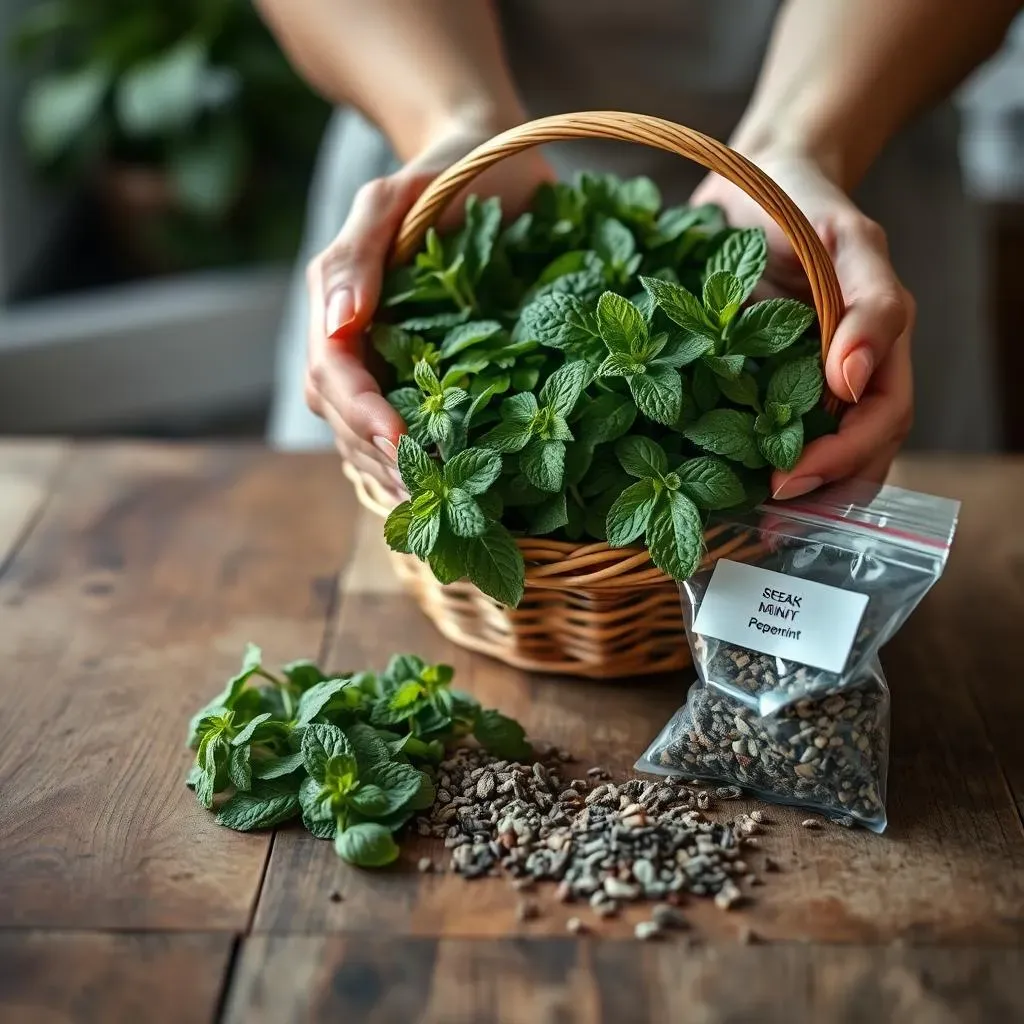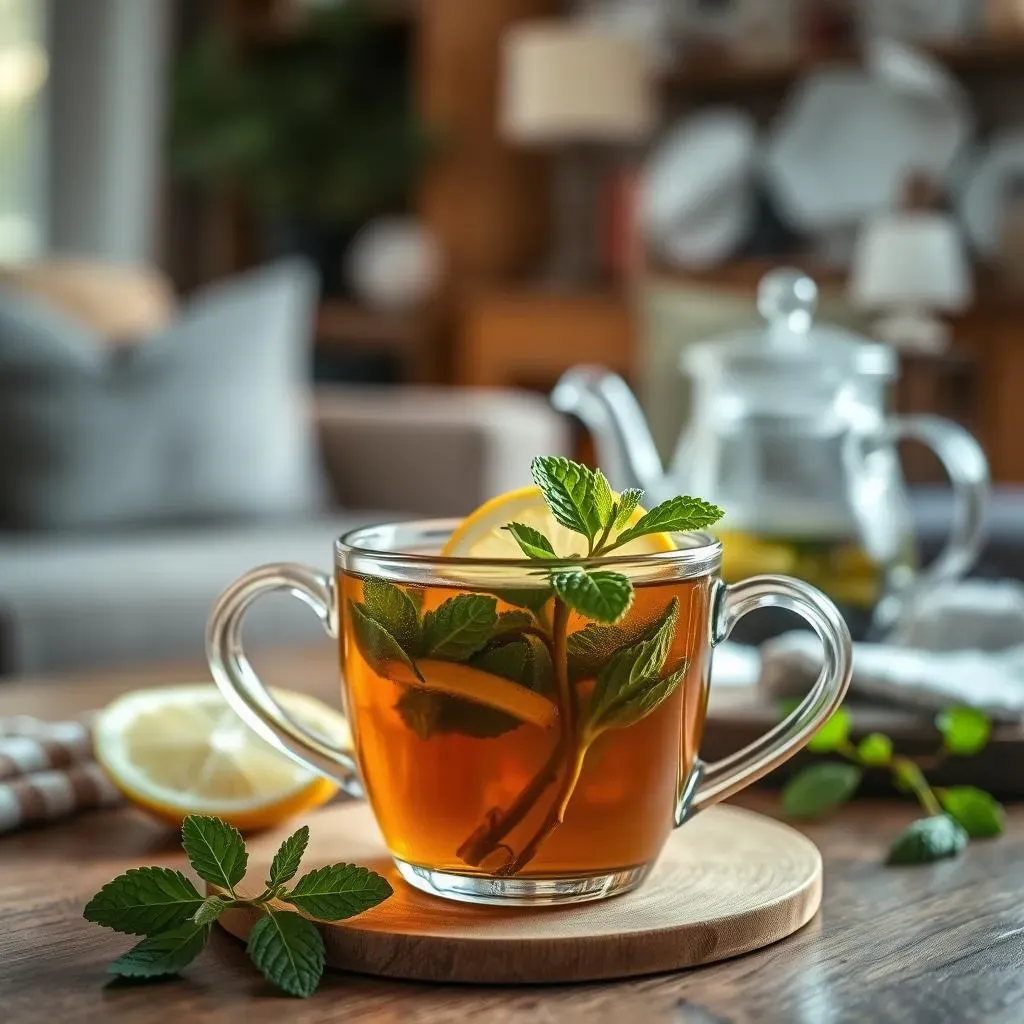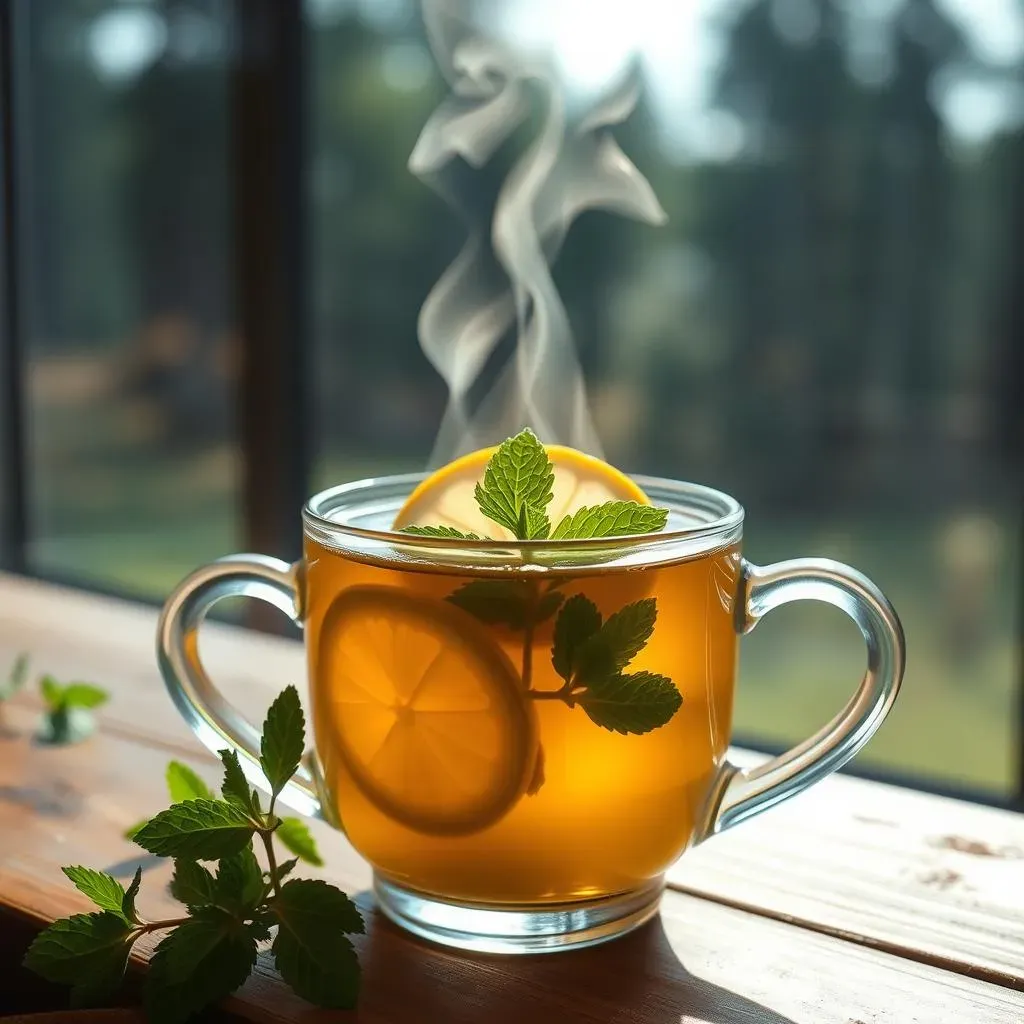Table of Contents
Ready to discover a wonderfully refreshing twist on your favorite herbal tea? This article is your complete guide on how to make spearmint tea with peppermint, a delightful blend that combines the subtle sweetness of spearmint with the invigorating coolness of peppermint. Whether you're a seasoned tea drinker or just starting your herbal tea journey, we'll walk you through everything you need to know, from choosing the right ingredients – fresh or dried – to mastering the perfect brewing technique. We'll also explore exciting flavor variations, showing you how to customize your tea with sweeteners, citrus fruits, and other additions to create your signature blend. Beyond the simple brewing process, we’ll uncover creative ways to use your homemade spearmint and peppermint tea, taking your tea experience to the next level. So grab your favorite mug, and let's embark on this aromatic adventure together! Prepare to be amazed by the simplicity and versatility of this incredible tea.
Gathering Your Ingredients: Fresh vs. Dried Herbs
Gathering Your Ingredients: Fresh vs. Dried Herbs
The Allure of Fresh Herbs
For the most vibrant flavor and aroma, fresh spearmint and peppermint leaves are your best bet. Think of it like this: fresh herbs are bursting with essential oils, giving your tea that bright, clean taste you crave. Imagine biting into a freshly picked mint leaf – that's the experience you're aiming for in your tea! You'll find both herbs easily at most grocery stores, farmer's markets, or even in your own garden, if you're lucky enough to have one. Just make sure to give them a good rinse before you start brewing. For a truly intense flavor, consider using a slightly larger quantity of fresh mint. Want to learn more about using fresh mint? Check out our guide on how to make spearmint tea with fresh mint.
Using fresh herbs is a sensory experience. The aroma alone is enough to transport you to a tranquil garden. Plus, you get to enjoy the visual appeal of the leaves as they unfurl in your cup. There's a certain satisfaction in working directly with nature's bounty, knowing that you're creating a drink from the freshest ingredients. It's a simple pleasure that elevates the entire tea-making process.
Herb | Flavor Profile | Availability |
|---|---|---|
Fresh Spearmint | Sweet, slightly grassy | Grocery stores, farmers markets |
Fresh Peppermint | Cool, invigorating | Grocery stores, farmers markets |
The Convenience of Dried Herbs
If fresh herbs aren't readily available, or if you prefer the convenience of having them on hand year-round, dried spearmint and peppermint are excellent alternatives. While the flavor might be a bit more subdued compared to fresh herbs, dried herbs still offer a lovely minty taste. Think of dried herbs as a concentrated version of their fresh counterparts. You'll need less to achieve the same level of flavor. When using dried herbs, you might want to experiment with the steeping time to find your ideal strength. If you're curious about other ways to use dried mint, take a look at our article on making spearmint tea with dried mint.
Dried herbs are incredibly versatile. They're lightweight and easy to store, making them perfect for travel or for keeping a stash in your pantry for those spontaneous tea moments. They also offer a longer shelf life than fresh herbs, ensuring you always have the ingredients for a delicious cup of tea on hand. Remember, though, that the flavor intensity might vary depending on the brand and how long the herbs have been stored. So, always check the package date for the freshest experience!
- Dried spearmint offers a slightly less intense flavor than fresh.
- Dried peppermint provides a concentrated minty taste.
- Store dried herbs in an airtight container in a cool, dark place.
Brewing Your Perfect Cup: StepbyStep Guide
Brewing Your Perfect Cup: StepbyStep Guide
Heating the Water: The Foundation of Flavor
First things first: get your water nice and hot! Boiling water is key to unlocking the full flavor potential of your herbs. Think of it like this: hot water acts like a key, opening up the leaves and releasing all those delicious essential oils. You can use a kettle, a stovetop pot, or even your microwave – whatever works best for you. But aim for a rolling boil, that bubbly, energetic action that shows the water is truly hot. Don't worry about being too precise here – a good, vigorous boil will do the trick. Want to know the ideal temperature? Check out our guide on spearmint tea brewing temperature.
Once your water's boiling, let it sit for a minute or two. This allows it to cool slightly, preventing it from scorching the delicate mint leaves and creating a bitter taste. We’re aiming for a gentle extraction of flavor, not a violent assault on the leaves! A little patience goes a long way in tea-making.
- Use filtered water for the purest taste.
- Avoid using hard water, as it can affect the flavor.
- Let the water cool slightly before adding the herbs.
Steeping the Herbs: The Art of Patience
Now comes the fun part: steeping your herbs! Add your chosen amount of spearmint and peppermint leaves to your teapot or mug. If you’re using fresh herbs, a handful is a good starting point. For dried herbs, start with a teaspoon and adjust to your taste. Remember, you can always add more, but you can't take it away! Once the herbs are in, pour the hot water over them. Gently swirl the water to ensure all the leaves are submerged. This helps them release their flavor more effectively.
Now, patience is key. Let the tea steep for 3-5 minutes for fresh herbs, or 5-7 minutes for dried herbs. The longer you steep, the stronger the flavor will be. Experiment to find your perfect balance. Once the steeping time is up, remove the leaves. You can use a strainer or simply pour the tea through a fine-mesh sieve. If you're interested in perfecting your steeping technique, check out our article on steeping spearmint tea.
Herb Type | Steeping Time (minutes) | Flavor Intensity |
|---|---|---|
Fresh Spearmint & Peppermint | 3-5 | Mild to Medium |
Dried Spearmint & Peppermint | 5-7 | Medium to Strong |
Sweetening and Serving: The Finishing Touches
Your tea is almost ready! Now's the time to add any sweeteners or flavor enhancers you prefer. Honey is a classic choice, complementing the minty flavors beautifully. Lemon juice adds a zesty kick, while a touch of maple syrup provides a subtle sweetness. Feel free to experiment and find what you enjoy most! Remember to add your sweetener while the tea is still warm, ensuring it dissolves completely.
Once you've added your chosen additions, pour your tea into your favorite mug and enjoy! A sprig of fresh mint or a slice of lemon can add a lovely visual touch to your cup. Whether you prefer your tea hot or iced, this blend is incredibly versatile. For iced tea, simply let the brewed tea cool completely before pouring it over ice. You can even make a large batch ahead of time and store it in the fridge for later. For some inspiration on iced tea variations, take a look at our recipe for iced spearmint tea.
Flavor Variations and Tweaks: Sweeteners, Citrus, and More
Flavor Variations and Tweaks: Sweeteners, Citrus, and More
Sweetening Your Brew: Honey, Maple, and More
Let's talk sweetness! A touch of honey is a classic pairing with mint tea, complementing its refreshing qualities. The natural sweetness of honey enhances the minty notes without overpowering them. Think of it as a gentle embrace, not a forceful takeover. If you're feeling adventurous, try a drizzle of maple syrup for a slightly more robust sweetness. It adds a unique depth of flavor that complements the herbaceous notes of the mint. For a less intense sweetness, consider using a sugar substitute like stevia or agave nectar. Remember, a little goes a long way – start with a small amount and adjust to your liking. Want to explore more honey-infused tea recipes? Check out our guide on making perfect spearmint tea with honey.
Experimenting with sweeteners is all about finding your personal preference. Some people prefer a subtle sweetness, while others enjoy a more pronounced sugary taste. The beauty of homemade tea is that you’re the boss! Don't be afraid to try different sweeteners and discover your perfect balance.
- Honey: Adds a natural sweetness and floral notes.
- Maple Syrup: Offers a deeper, more complex sweetness.
- Agave Nectar: Provides a slightly less sweet alternative.
- Stevia: A sugar-free option for a subtle sweetness.
Citrus Zest: Lemon, Lime, and a Burst of Freshness
Now, let's add some zing! A squeeze of fresh lemon juice brightens up the minty flavors, adding a delightful tartness that cuts through the sweetness. The citrus notes complement the mint, creating a refreshing and invigorating combination. Think of it as a dance of flavors, each one enhancing the other. If you're feeling adventurous, try a squeeze of lime juice for a slightly different twist. Its tangy notes offer a unique contrast to the cool mint. Just remember to add the citrus juice after brewing, to avoid affecting the steeping process. For another citrusy twist, have a look at our recipe for spearmint tea with lemon.
Adding citrus is a simple yet effective way to elevate your tea experience. The bright acidity balances the sweetness and herbaceousness of the mint, creating a complex and satisfying flavor profile. Don't be afraid to experiment with different citrus fruits to discover new flavor combinations.
Citrus Fruit | Flavor Profile | Suggested Amount |
|---|---|---|
Lemon | Tart, bright | 1/2 - 1 teaspoon juice |
Lime | Tangy, slightly sweet | 1/2 - 1 teaspoon juice |
Beyond the Cup: Creative Uses for Your SpearmintPeppermint Tea
Beyond the Cup: Creative Uses for Your SpearmintPeppermint Tea
Infuse Your Cooking: Savory and Sweet Applications
Don't limit your mint tea to just a beverage! Its refreshing flavor profile works wonders in both sweet and savory dishes. Imagine adding a splash of cooled mint tea to your favorite fruit salad for an extra layer of minty coolness. Or, use it as a base for a unique vinaigrette, adding a touch of sophistication to your salads. The possibilities are truly endless. For more ideas on using mint in cooking, you might enjoy our guide on making spearmint tea with fresh mint, which explores the culinary uses of fresh mint leaves.
Think outside the box! Mint tea can be used to create unique marinades for grilled meats or fish, adding a refreshing twist to traditional flavors. It also pairs beautifully with lamb, adding a subtle minty note that complements the richness of the meat. And don't forget desserts! A mint tea reduction can elevate your ice cream or panna cotta to a new level of deliciousness.
- Fruit salads: Add a refreshing minty twist.
- Vinaigrettes: Create a unique and flavorful dressing.
- Marinades: Infuse meats and fish with minty notes.
- Desserts: Elevate your sweets with a mint tea reduction.
Homemade Beauty Treats: Refreshing Skin and Hair
Did you know that your spearmint-peppermint tea can also be a star in your beauty routine? Once cooled, the tea makes a fantastic toner for your skin. Its natural properties can help soothe irritated skin and reduce redness. Simply apply it to your face with a cotton pad after cleansing. For an extra pampering experience, use it as a final rinse after shampooing your hair. The minty scent is invigorating and leaves your hair feeling incredibly soft and refreshed. If you want to explore other ways to use mint for beauty treatments, you might be interested in our article on making spearmint tea with lavender, which delves into the soothing properties of lavender and mint.
The possibilities for DIY beauty treatments are vast. You can also use the cooled tea to create a refreshing facial mask by mixing it with other natural ingredients like honey or yogurt. For a soothing foot soak, add a generous amount of cooled tea to a basin of warm water. The minty scent and cooling properties will leave your feet feeling relaxed and revitalized.
Beauty Use | Benefits | Application |
|---|---|---|
Facial Toner | Soothes irritated skin, reduces redness | Apply with cotton pad after cleansing |
Hair Rinse | Softens hair, adds shine | Use as final rinse after shampooing |
Beyond the Mug: Creative Cocktail and Mocktail Ideas
Let’s get creative with cocktails and mocktails! The minty coolness of your spearmint-peppermint tea can form the base of some truly delightful drinks. Imagine a refreshing mojito-inspired mocktail, using the tea instead of plain water, and muddling in some fresh berries and lime. Or, for a more sophisticated beverage, try adding a splash of your tea to a sparkling wine or gin and tonic for a unique twist. The minty notes complement the bubbly drinks, creating a refreshing and sophisticated taste. For more ideas on brewing the perfect base for your favorite beverages, take a look at our article on brewing spearmint tea.
The versatility of your homemade tea is remarkable. You can experiment with various fruits, herbs, and spices to create your own signature cocktails and mocktails. Don't be afraid to experiment and find your favorite combinations. Remember to always drink responsibly.